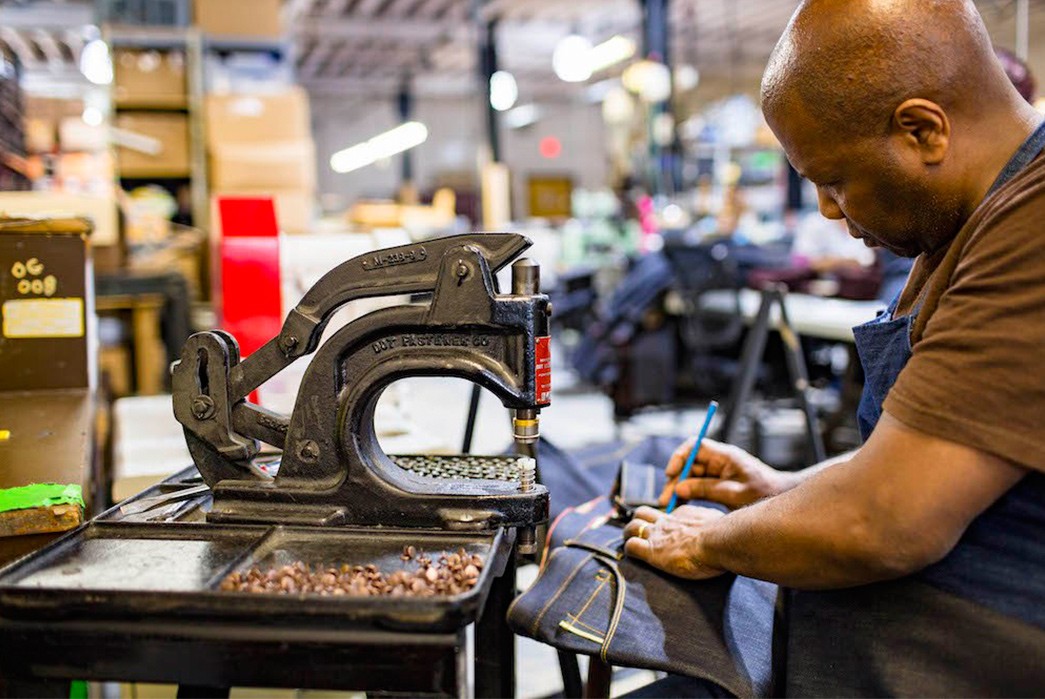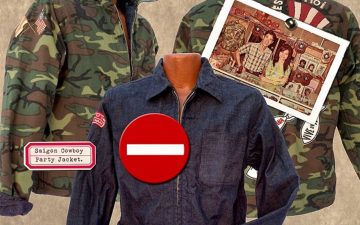In late March, Governor Cuomo of New York begged businesses to begin making masks, “If you can make them, we will give you funding to do it.” The request seems reasonable until you take a step back and look at the situation in the United States. We are one of the most powerful developed countries in the world, but we aren’t able to make something as simple as surgical masks.
Governor Cuomo’s plea came in the midst of a global pandemic, one that we found ourselves horribly underprepared for. The last few months have exposed not only glaring weaknesses in our social safety net in times of crisis, but they’ve also shown just how dependent our country is on foreign manufacturing to obtain even the most basic things.
Globalization theoretically makes things cheaper and more accessible, but if any one piece of the supply chain collapses, the entire world starts shutting down. Our interconnectedness, which is often our strength, has, during the coronavirus outbreak, become our greatest weakness, transmitting the illness and putting healthcare workers at risk.
Crimson Contagion
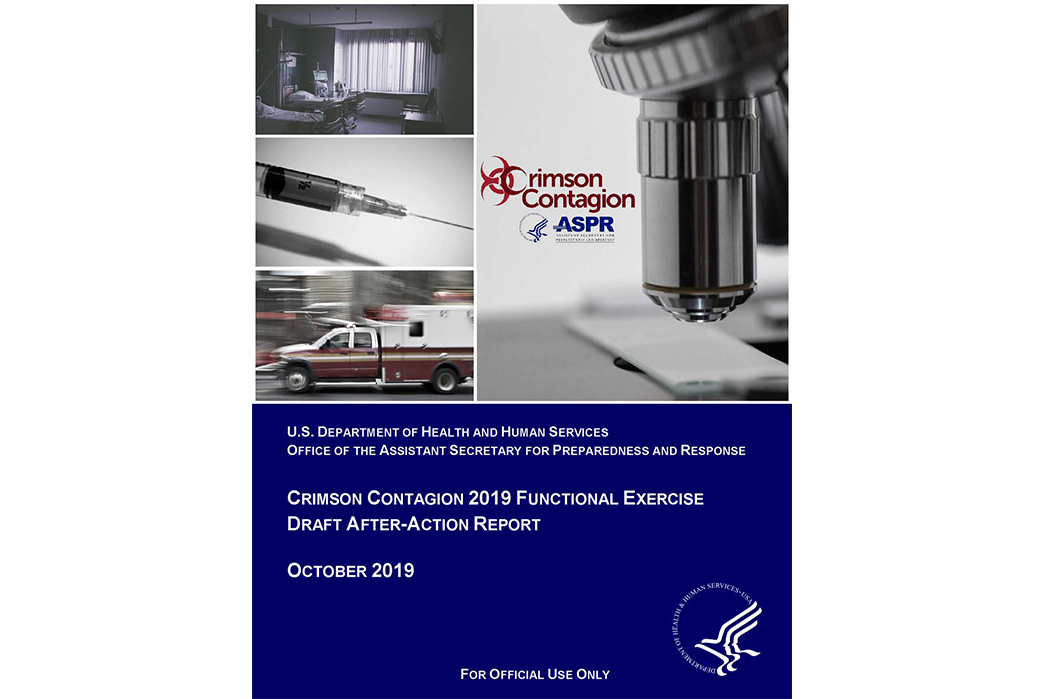
Crimson Contagion. Image via Daily Kos.
Mid-March, around the time Cuomo was begging companies to begin manufacturing medical equipment, President Trump said in a meeting, “Nobody knew there would be a pandemic or epidemic of this proportion. Nobody has ever seen anything like this before.”
Despite such claims by the Trump administration that our country was caught totally off-guard by the Covid-19 outbreak, several precautions had been taken to test our nation’s disaster-readiness and often with the same glaring problems.
Drills run during the Obama administration around the time of the Ebola outbreak revealed that the U.S. had a critical lack of medical equipment and no clear way to quickly bolster stockpiles. In response to this, Congress allocated $5.4 billion in emergency funding to combat Ebola, much of which went to a little-known agency in the Department of Health and Human Services.
Anxieties about Ebola proved to be largely unfounded, but the Congressional funding did make a lasting impact by making an office in the National Security Council entirely dedicated to pandemic response and writing a 69 page pandemic playbook.
Despite significant defunding and restructuring in the Trump era, this same small agency in the Department of Health ran a huge simulation called “Crimson Contagion,” starting in January 2019. The simulation made use of dozens of federal agencies and exposed huge problems in the nation’s pandemic response.
Despite cooperation by the Trump administration, by the time the exercise had been completed and the findings announced, many of those key Trump team-members had been fired or had moved on. The findings were largely consistent with the Obama administration’s observations… namely that the country was unprepared for a serious pandemic.
When the pandemic became serious in the U.S., all the issues raised in Crimson Contagion became obvious.
Not enough masks, not enough ventilators. Various large-scale blunders by the Trump administration, including restructuring the Obama-formed pandemic office, ignoring the pandemic playbook, and even firing key liaisons between the White House and the Crimson Contagion effectively hobbled every available defensive measure.
When the virus began wreaking havoc in China, where nearly 50% of our masks are made, our supply started running dry (as predicted), when it hit Italy, where many of the swabs needed for covid testing are produced, those too ran out.
Countries began hoarding their supplies, digging in for zero hour, and any countries that produced their own medical and protective equipment diverted their supplies inward, for their own citizens’ well-being. As anticipated, the supply chains broke down and we found ourselves in a country gutted of its industry—a place that can’t fend for itself.
De-Clawing American Industry
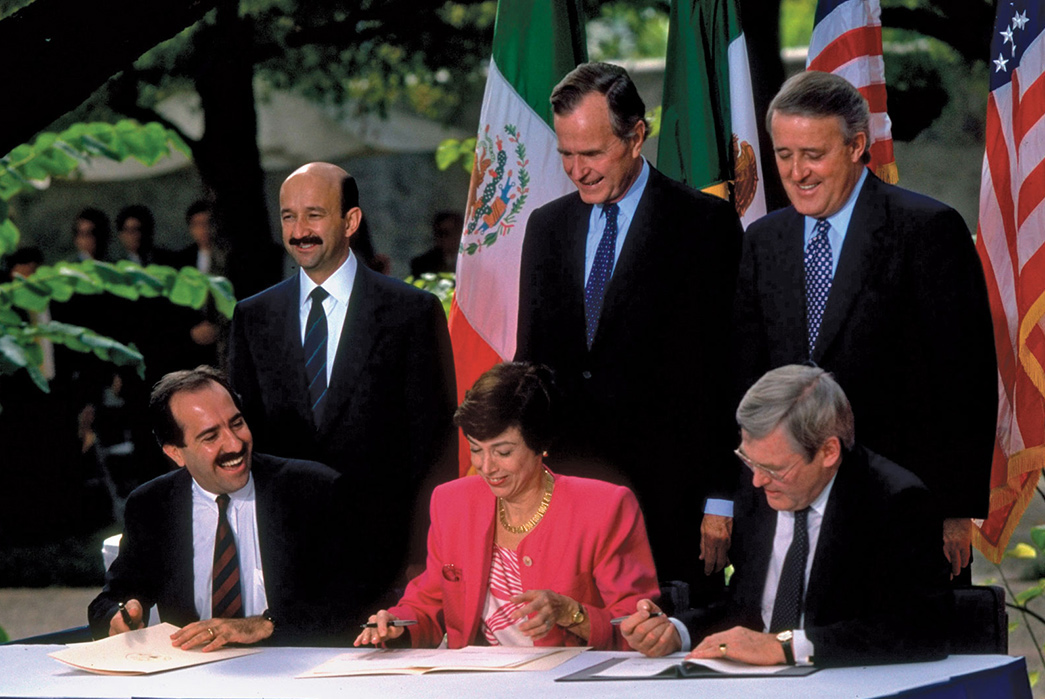
NAFTA signing in 1992.
Historically, industry has been one of our country’s greatest assets. Our productivity and manufacturing prowess won us two world wars, establishing us as a world power. Since those long-past glory days, we have chiseled away at the foundation of that source of American pride. Now, in a time of crisis, with our sources of cheap, foreign labor cut off, we find ourselves nearly helpless.
This depredation of American industry has gone on for some time, but hit a fever pitch in the 80s and 90s. The powers-that-be have asserted that these measures will be good for American businesses and therefore good for average Americans.
But that was never true. How can it be? So profoundly have we altered the American manufacturing space that we cannot make simple surgical masks, let alone ventilators, syringes, and more complex pieces of equipment.
In 1965, manufacturing accounted for 53% of the American economy. By 1988, that number dwindled to 39% and by 2005, it was less than 10%. By the early 2000s, many of the last great American manufacturing giants closed their doors entirely, like Bethlehem Steel and others, like Levi’s, moved all of their production overseas.
When manufacturing leaves the country, not only do those blue collar jobs leave, but so do many of the white collar ones. Hundreds of thousands of jobs flushed away, leaving us bereft of any manufacturing ability, but why and how?
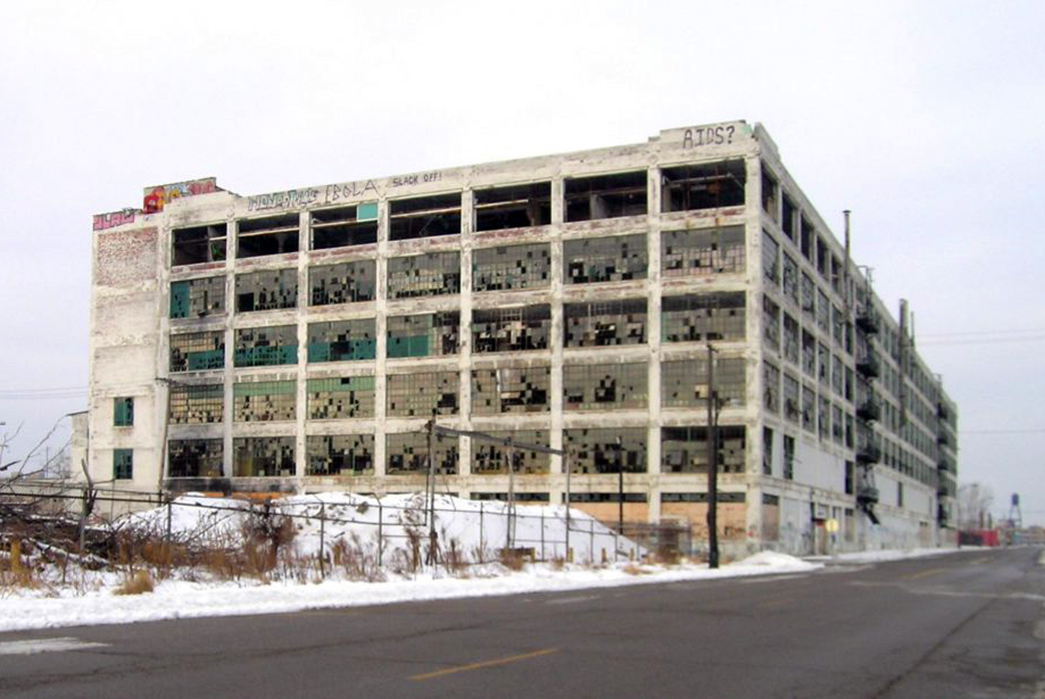
Empty Packard Plant in Detroit. Image via Hemmings.
For the most part, the driving force behind these changes (besides good, old-fashioned greed) is globalization. Our interconnectedness may be culturally beneficial, but this “increased mobility of goods, services, labor, technology and capital throughout the world,” (as explained by Trumpet) makes it all too easy to send American jobs elsewhere.
It was inevitable, that once other economies began opening up, that American businesses would start finding their labor elsewhere. American workers are productive, but they are also expensive. Worker protections in the U.S., though hardly as stringent as in other developed nations are still far more stringent than those in developing nations.
It winds up being far more profitable for companies, even with expensive import fees, to manufacture elsewhere, because it would be a crime to pay an American so little.
The death knell for American manufacturing was written into law in 1992 in the form of NAFTA. The North American Free Trade Agreement went into effect in 1994 and effectively tripled trade between Canada, Mexico, and the United States.
This trade increased the three country’s economic output, but the wealth wasn’t evenly distributed, of course. Jobs were created, but not necessarily in the U.S.—many companies moved their production to Mexico, where labor laws were more relaxed and where their profit margins would be increased.
This job migration to Mexico also suppressed wages in the U.S. Now, if an American factory tries to unionize, the bosses can merely threaten to take the whole operation to Mexico, something far easier under NAFTA. Leveraging cheaper labor abroad has become so prevalent that American productivity has grown more at a rate 600% higher than wages.
There are still more downsides to NAFTA. The Act effectively put small Mexican farmers out of business, by letting subsidized American agribusiness take hold in Mexico. These businesses wished to take advantage not only of cheap labor, but of lower environmental standards as well.
These businesses gravely affected the environment in Mexico and caused emigration from the country to sky-rocket, by putting so many local farmers out of business with their aggressively low prices.
What it Means for Us Today
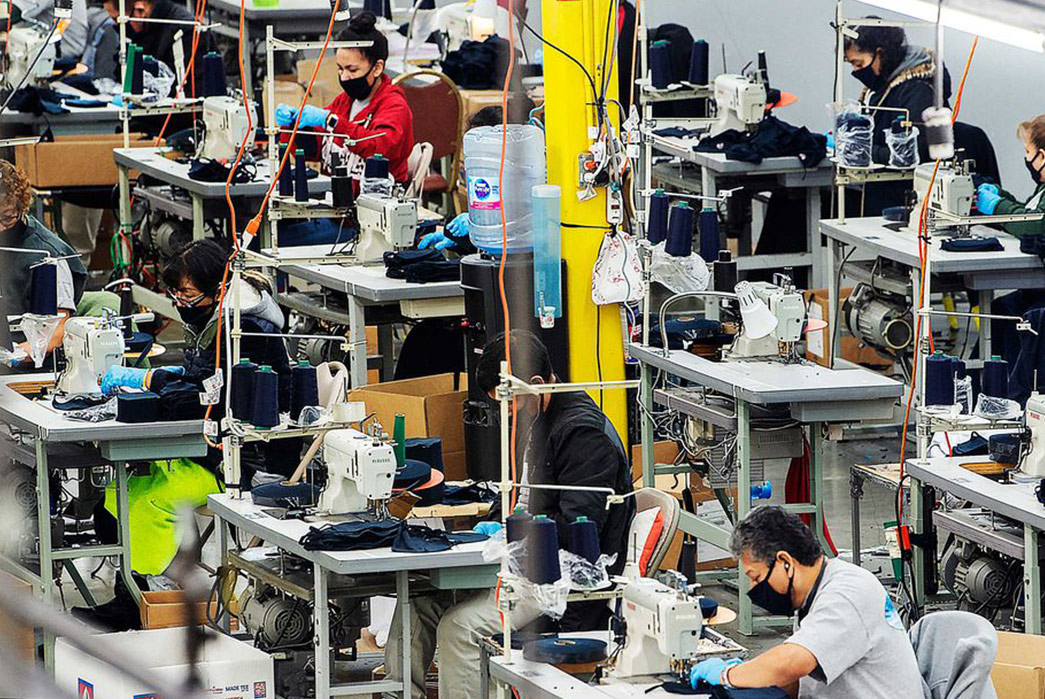
A manufacturer in Brea, California, switches over from making athletic wear to masks. Image via Vox.
The end-result of the globalization, outsourcing, NAFTA mess is that our country imports twice what it exports. This tenuous position made us almost entirely dependent on very complex international supply chains to get the goods and services we require.
Now that the Covid-19 outbreak has disrupted many of these, we are seeing profound shortages in exactly what Crimson Contagion predicted—PPE and medical equipment.
Alex Wasserman, an EMT in Los Angeles, relayed a haunting image. “The hardest thing is when we go into hospitals with confirmed [Coronavirus] cases, we see nurses on 8-15 hour shifts with no N-95 masks, sometimes just a surgical mask or maybe two, and they’re always asking us for extra N-95s.”
Healthcare workers on the front lines, fighting a dangerous and infectious disease are literally begging one another for necessary equipment. The federal stockpile, both of masks and ventilators is being distributed, but even that is not enough.
Private companies, with and without government support are hurrying to meet the demand, but the fact of the matter is that enough of these products were never made here. Though it’s impressive that garment manufacturers can turn around and make masks and gowns, part of our unsustainable pattern of outsourcing is that those specific manufacturers are halfway across the world, locked down.
It is unconscionable that over 40,000 Americans have died during a crisis we have long predicted, deprived of material we could easily make… if it was more profitable.
The Hangers-On
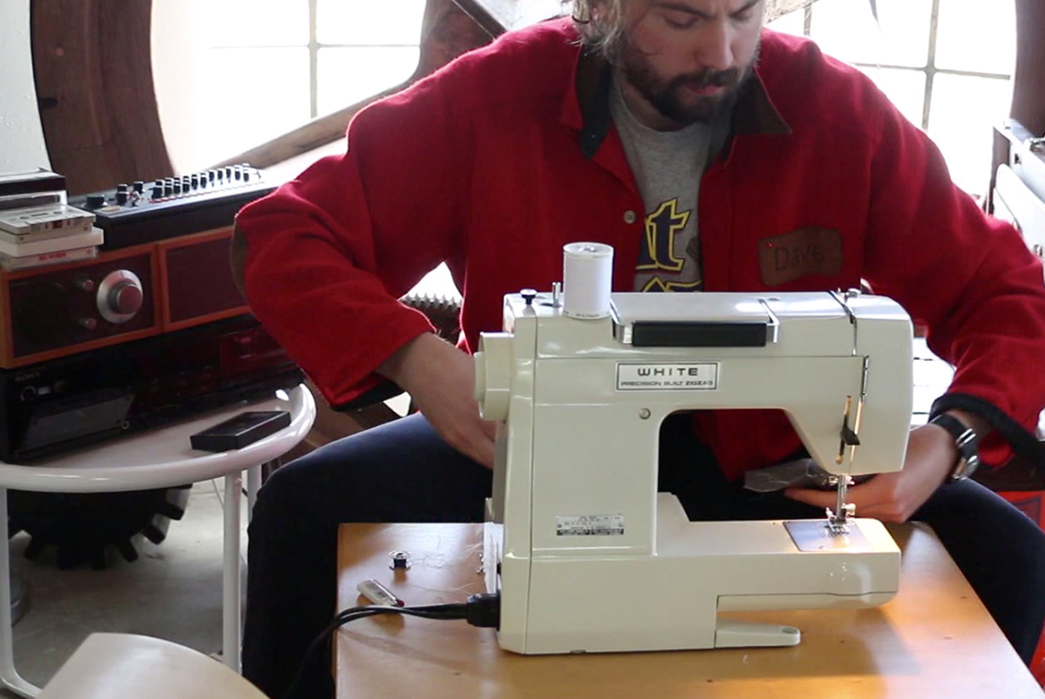
Our very own editor, David Shuck, sews masks for our non-profit mask project Cover Up Colorado. Image via The Denver Channel.
Though, as we’ve discussed, it is much cheaper and more efficient to manufacture out of the country, there are still hangers-on. In fact, you know many of them, as they’re frequently hosted on our site. Though they aren’t medical supply companies, they are skilled artisans with great equipment and something that’s been so lacking in many of these trade deals we’ve discussed—a conscience.
Small American clothing companies are no strangers to adversity, but while many larger companies have immediately floundered in the time of Coronavirus (…the airlines…), these smaller operations that produce domestically are shining. The whole fashion world is struggling right now, losing pre-orders and payments, but those who kept all their team in-house, are lean and mean enough to turn it around.
Gitman Bros., Shockoe, Railcar Fine Goods, Runabout Goods, Winter Session, Hartford Denim Co., Raleigh Denim, Indigoproof, Naked & Famous, and dozens of other small makers have all changed up their normal production to make what’s most needed now.
Raleigh Denim‘s team of four sewers was able to churn out 2,000 masks in short order, the majority of which were donated to vulnerable workers in essential industries. Not only can these domestic brands help their communities, they’ll be far better off to help themselves when the economy begins to open back up.
Andrea, the Customer Experience Associate at Raleigh related to me, “Since our core products are made in-house we are able to pivot our business quickly depending on our needs. We will be able to restock core styles faster than we would if this type of production was outsourced, so it is a major benefit. ”
When asked how this catastrophe may change fashion, Andrea had a prediction, “I think, and I hope, it shifts the consumer mindset from consuming fast fashion to considering the longevity and quality of products. In the retail landscape I think and I hope that it reminds people of the importance of small business and keeping your dollars in your community.”
Because if this happens again, we know this administration has little to no interest in protecting us, our industry, or our jobs. So we must rely on each other, support our artisans, craftspeople, and essential workers; a tough job that begins and ends on the home front.

